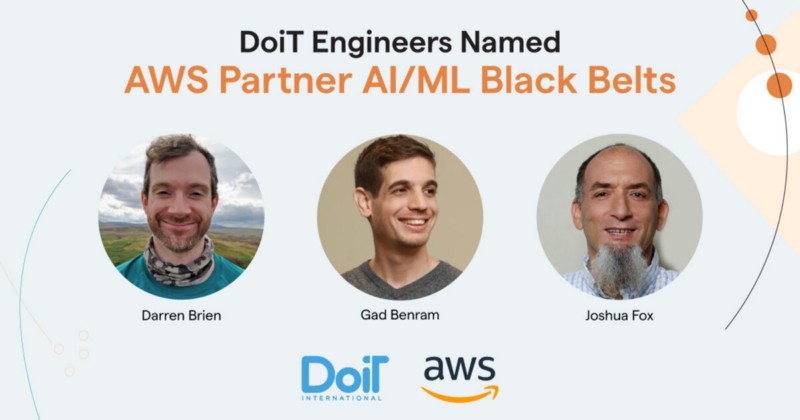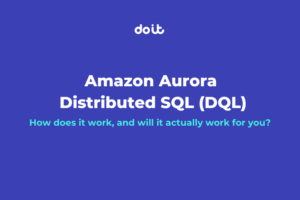
Or, how we did a pilot of this advanced certification program
Authored with my colleagues at DoiT International, Gad Benram and Darren Brien
Introduction
Recently, the three of us joined a pilot run of the AWS Partner Black Belt program in Machine Learning and Artificial Intelligence and earned our certifications. In this post, we’ll describe the program, including the learning sessions and the final project.
In the past, we have earned certifications from cloud providers, including the AWS Certified Machine Learning Specialty. The Black Belt is a higher level of certification that represents deep experience rather than potentially crammed knowledge. Instead of a multiple-choice exam, it is evaluated with a final capstone project, roughly at the difficulty level of a university term project.
Participants were ML practitioners working in the AWS cloud. The instructors and evaluators were AWS architects and product managers specializing in the field.
Our specializations at DoiT International differ from cloud infrastructure to ML, and our responsibilities range from advising customers to developing ML systems. Still, the program was suited to each of us, and perhaps to you too.
Lectures and Labs
Below, we’ll describe some of the essential elements of AWS ML that we covered. If you already know all this — great! Passing will be a cinch! But more likely, even if you have years of experience, you have not worked with the full range of AWS offerings across the ML workflow, and this is your chance to learn.
The program starts with online learning sessions, about 10 hours a week for four weeks. These include lectures, structured walkthroughs of technologies, and live labs. The program’s second half is the capstone project, with about that same time commitment.
Give me some data
The first step towards ML projects is to ask: “Where’s your data?”
AWS has several solutions for ingesting, discovering, and transforming data to make it readily available and usable for ML projects.
The Kinesis and Glue service suites form a powerful combination for serverless ingestion and transformation as data arrives in real-time. Another solution for transformation is EMR, a managed Hadoop ecosystem. All these generally put their output in S3, the go-to data storage option in Machine Learning.
The next step in data management is building a massive collection of data that can be analyzed for business insights and patterns useful in ML training. Glue Data Catalog captures your data’s location and schema, while Lake Formation sets up paths for your data together with granular sets of permissions.
Next, you can analyze the data with SQL using the powerful engines of Athena on top of S3. Alternatively, instead of a lake of unstructured data in S3, you can use Redshift as a structured data warehouse.
Let Autopilot fly for you
Sagemaker Autopilot might let you skip a few steps. This tool chooses an algorithm that is likely to work and tries it across many different parameter values. It’s helpful for a quick first run, but you will get more accurate and less costly answers if you explore and prepare the data first, setting it up in a way that your algorithm can get its teeth into.
Explore before
You have to understand what you’re going to do before you do it, and that step is called Exploratory Data Analysis.
Visualization of full datasets can be done in the QuickSight business intelligence tool, but most EDA happens in Sagemaker Notebook, an interactive development environment for Python aimed at ML. You can preprocess, analyze, explore the data, and even run your modeling and evaluation with fast iterations, in preparation for using AWS’s scalable distributed services.
Can we finally do some ML, please?
At last, time to choose and run a machine learning algorithm. Amazon Sagemaker offers a range of algorithms out of the box: DeepAR, XGBoost, and about a dozen more, each with its own use cases. For better tuning, Sagemaker hyperparameter optimization lets you automatically experiment across values in multiple dimensions. If you’ve developed your own algorithms, you can bundle them into an ML container, and integrate them into the full power of the Sagemaker system.
Machine Learning Ops on AWS
The last part of the Black Belt program focused on delivering models into production: ML Ops. Amazon’s approach to this rapidly evolving area is an ML-centric AWS Well-Architected Five Pillars, based on practices that have become standard in software engineering.
The model is a-changing
As new data arrives, the inferences should reflect changes. Sagemaker Pipelines automates this process of training and deployment, creating versioning for APIs and models. The versions can be run alongside each other for end-to-end A/B testing. Model performance monitoring lets you see if the accuracy has slipped enough that retraining is needed.
Security is job zero
To control access on the network level, Sagemaker Notebooks, training jobs, and inference endpoints can each be deployed into your VPC. You also control access to each of these on the user level using IAM.
Keep it going
Sagemaker inferencing endpoints are available for on-demand or batch service. Sagemaker keeps these highly available with autoscaling and automatic failover as needed.
Capstone project
Implementing a solution is the best way to crystalize your learning; it is also the best way to show off your skills. We were excited to find that the Black Belt program included not only live labs, but also a four-week Capstone project. Each participant chose one of the ML projects in areas such as anomaly detection and preventive maintenance. The AWS team provided thoughtful guidance along the way, going the extra mile to make themselves available to us on Slack.
Our projects were graded against a comprehensive rubric, a grading guide listing technologies and solutions to be used across all aspects of delivering an ML system from ingestion to transformation, training, evaluation, and on to ML Ops.
Conclusion
We’re grateful for the support and guidance of the AWS team: Designing the program, delivering the training, and reviewing the capstone projects was no small undertaking.
The AWS AI/ML Black Belt is both an exclusive certification and a different way of learning. We recommend it to anyone who wants to take a step up in ML and demonstrate this to the world.
Thanks for reading! To stay connected, follow us on the DoiT Engineering Blog, DoiT Linkedin Channel, and DoiT Twitter Channel. To explore career opportunities, visit https://careers.doit.com.

